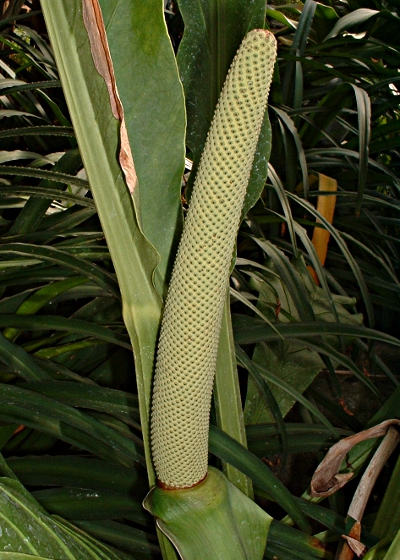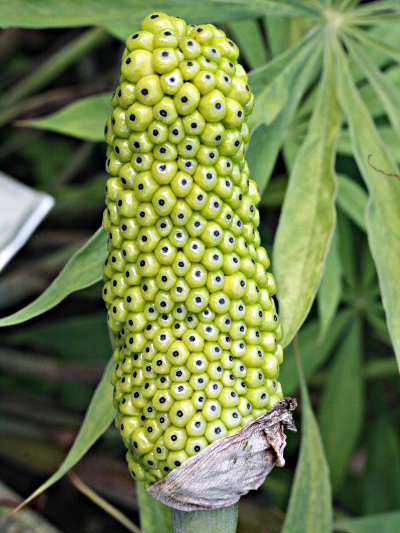Arum family |

Spadix of Anthurium cubaensis, a Cuban Araceae

Infructescence of Arisaema ciliatum, a species of the cobra lilies
The aroids are mostly perennial, often evergreen herbs, vines, aquatic and marsh plants and epiphytes. Also shrubby and greatly reduced plants occur. In some species underground rhizomes or tubers are formed, a genus of duckweed at all does not form roots. The mostly stalked leaves are alternating or seemingly basal, often with a sheathing base. Below them are often reduced, scale-like leaves (prophylls and cataphylls). Very different leaf shapes may occur: simple, sinuate or composed ones.
The small and inconspicuous, actinomorphic flowers are usually arranged in terminal spadices (singular: spadix). The flowers are either hermaphrodite or unisexual, in some cases, in the lower part of the spadix are female and at the top male flowers. At the bottom and at the top of the spadix sterile flowers may occur. The spadix is often wrapped by a bract which is generally cone-shaped, sometimes colored and sometimes scaly. It is called spathe.
Hermaphroditic flowers are missing either the petals, or there are 4, 6 or. 8. At least 4 stamens the hermaphroditic flower contains, but there also can be several. The superior ovary usually consist of 3 fused carpels, Sometimes there is only one carpel and rarely many ones. Male flowers usually contain only 1–12 free or fused, almost sessile stamens. Female flowers usually have only one ovary with a single stylus, on the apex with a head-shaped, semi-spherical, funnel-shaped or flat scar. In the Lemnoideae the spadix is often greatly regressed or missing.
After pollination the sometimes foul-smelling flowers by flesh flies or silphids or other flies and beetles, the superior ovary usually form few seeded, often red-colored berries that may grow together in the course of maturation in some species. In some genera stone fruits, nuts, achenes or capsules develop.
| Floral formula mostly: |
| *
P6 A4–∞ G(3) superior or ♂ * P0 A1–4 or A(2–12) G0 ♀ * P0 A0 G(1 or 3) superior |
Some Araceae store in special cells pointed, needle-like structures, mainly of calcium oxalate, which raphides are called and serve as protection against slugs.
The respiratory chain of thermogenic Araceae
Many Araceae during the flowering period can raise the temperature inside the spadix and thus evaporate the attractants for insects effectively. The reason is to be found in the respiratory chain. The respiratory chain is an electron transport system, which is localized in the mitochondrial membrane, and uses the energy that is released from the reaction of hydrogen and oxygen. It consists of 4 series-connected protein complexes and two smaller molecules, which receive electrons (e.g. of NADH) and pass them from one complex to the next.
The electrons lose in each step a little energy, which is used for pumping protons out of the mitochondrion into the intercellular space. Only at complex IV, which is also a proton pump, water is formed. The protons pumped out of the mitochondrion create an electrochemical gradient, which the ATP synthase uses to store energy in the form of ATP. The Araceae have developed a way to short-circuit the respiratory chain. Usually ubiquinone transfers the electrons from complex II to complex III, but they may be transferred to the so-called alternative oxidase in some Araceae, which reduces the oxygen directly to water. The energy emitted is immediately released as heat.
Ornamentals
Among the aroids are many ornamentals and houseplants. The most known are probably golden pothos (Pothos, Scindapsus), Monstera, calla lilies (Zantedeschia), Philodendron, Alocasia, Spathiphyllum, Diffenbachia, Aglaonema, Sauromatum, flamingo flower (Anthurium) and many other more.
Interesting notes
The largest flower in the world, which is actually an inflorescence, has the titan arum (Amorphophallus titanum). The smallest flowers form the duckweeds (Wolffia ssp.).
Some plants in the genus Stylochiton develop a more or less underground inflorescence, which is almost entirely covered by the spathe. Only at the top there is a small hole through which the pollinator can reaching the flowers.
The voodoo-lily (Typhonium ulcers) is a tropical plant that is occasionally available as a tuber. It is placed on the window sill without soil, and it produce a long inflorescence. After flowering, the plant needs to be potted.